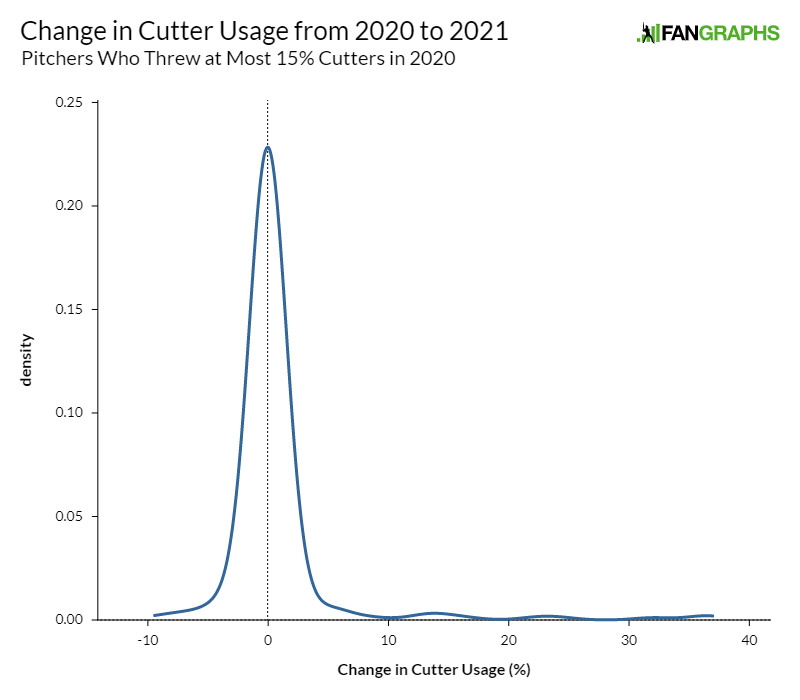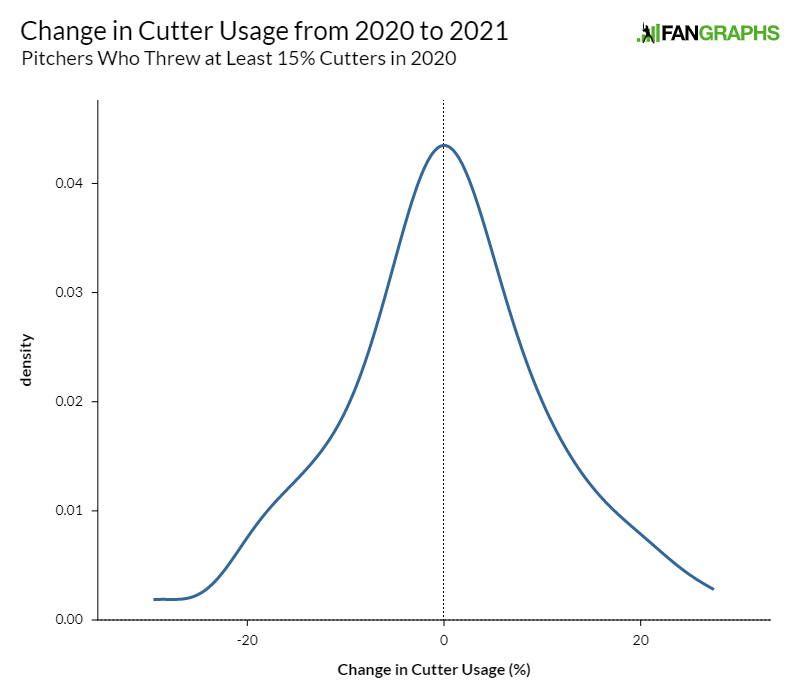The Cutter: A Platoon Neutral Offering?
Pitchers are always looking to chip away at the platoon advantage. Two of the most common weapons in doing so are the changeup and curveball. The former fades away from opposite-side batters and from the barrel as the bat whips through the zone. Most of a curveball’s movement, meanwhile, is vertical; no matter the handedness of the batter and corresponding bat path, the pitch can duck under the bat as the batter makes contact. Sliders, though, generally have a large platoon split, to the detriment of the pitcher, as they move more horizontally relative to vertically and toward the pitcher’s glove side. This leads the ball towards the barrel of an opposite-handed hitter, giving him more of an opportunity to make contact.
Cutters are interesting in this regard. Given the movement of the pitch, you would expect it to have significant platoon splits like a slider. The ball moves toward a pitcher’s glove side, albeit generally not as far as a slider; an opposite-handed hitter would have a better chance putting the barrel on it. But this is not the case, according to research from Max Marchi done back in 2010, as he found that cutters were in the middle of the pack with respect to pitch-type platoon splits. It still had more favorable splits when the batter had the platoon advantage, but that is the case for all pitches in general.
So why does the cutter not have much of an effect on the platoon advantage despite its break? As MLB.com explains it, the magnitude of the horizontal break is subtle enough to catch a hitter expecting a four-seamer off guard. Thus, when he swings, the movement of the pitch forces the batter to fight it off his hands and either induces weak contact or breaks the bat altogether. My thesis was that players are turning to the cutter because of these neutral platoon splits, as heavily using a pitch that works well to hitters from both sides makes you harder to predict.
Part of why I wanted to look into this is that cutter usage has been on the rise across the majors. From 2018 through ’21, the league as a whole has increased its usage of the pitch by about 14%. Anecdotally, a number of players have either added cutters to their repertoires or made it a larger part of their pitch-type diet. Corbin Burnes is the first that comes to mind. Joe Musgrove’s turn to the cut fastball has been discussed across baseball media, too. In Lucas Apostoleris’ write-up for Baseball Prospectus of the new pitches that have popped up in 2021, you’ll find Jakob Junis, Kyle Gibson, and Shohei Ohtani, all of whom now have cutters in their arsenals.
So let’s dig in further. The following is a table of pitchers who have thrown at least 50 cutters this season, sorted by highest CSW% (all stats for this piece are through May 9):
| Name | Cutter Usage (%) | Change in Usage (%) | SwStr% | CSW% | wOBA |
|---|---|---|---|---|---|
| Dustin May | 18.3 | -6.3 | 25.0 | 44.1 | .237 |
| Dean Kremer | 18.2 | -0.9 | 16.4 | 42.4 | .441 |
| Ryan Helsley | 31.0 | -4.6 | 21.1 | 40.8 | .317 |
| Jakob Junis | 35.1 | 35.1 | 22.6 | 38.7 | .184 |
| Trevor Bauer | 23.3 | 3.6 | 15.2 | 38.2 | .338 |
| Corbin Burnes | 53.7 | 22.2 | 16.7 | 38.2 | .183 |
| Joe Musgrove | 24.2 | 18.0 | 11.7 | 37.5 | .423 |
| Trevor Cahill | 17.1 | 4.7 | 21.9 | 37 | .350 |
| Mark Melancon | 61.8 | 6.7 | 7.1 | 36.5 | .203 |
| Yu Darvish | 37.4 | -6.2 | 11.5 | 35.6 | .495 |
| Charlie Morton | 12.0 | 3.2 | 9.2 | 33.8 | .475 |
| Brooks Raley | 42.9 | -2.6 | 17.2 | 33.4 | .440 |
| Luis Garcia | 19.8 | 9.9 | 28.7 | 32.5 | .115 |
| Kyle Gibson | 15.0 | 15.0 | 14.4 | 32.2 | .297 |
| Ryan Yarbrough | 46.1 | 10.1 | 11 | 31.6 | .36 |
Only five of the pitchers on this list decreased their usage of the cutter, and of those five, Darvish, Helsley, and Raley still used it at least 30 percent of the time. When you look at the other 10, six (if you round up Garcia’s 9.9% usage) increased their cutter usage by at least 10 percent, most notably two of the pitchers in Apostoleris’ piece (Junis and Gibson) as well as Burnes and Musgrove.
Overall, though, it seems that pitchers who already used the cutter as more than a show-me pitch account for more of the increase in league-wide cutter usage.


On average, pitchers who used the cutter less than 15 percent of the time throw it about the same amount. Most of the league-wide gains are from pitchers who already utilized the cutter in 2020. Perhaps this phenomenon can be attributed to pitchers who already felt comfortable with the pitch using it more because it can be effectively leveraged against left- and right-handed hitters.
The study I cited earlier from Max Marchi was from 11 years ago. Do the relatively neutral platoon splits for the cutter still hold? The answer in 2021 is a resounding yes for right-handed pitchers and a yes, but with a caveat, for lefties. (Note that the run values are from the perspective of the batter, so a negative figure is beneficial to the hitter.)
| Pitch Throws | Batter Stands | n | SwStr% | Called-Strike% | CSW% | wOBA | Run Value per 100 |
|---|---|---|---|---|---|---|---|
| L | L | 666 | 13.2 | 14.3 | 27.5 | .310 | -0.09 |
| L | R | 2327 | 9.4 | 15.7 | 25.1 | .358 | 0.35 |
| R | L | 3076 | 11.6 | 14.5 | 26.1 | .313 | -0.14 |
| R | R | 3486 | 14.1 | 16.2 | 30.3 | .313 | -0.2 |
For left-handed pitchers, there is a 48-point wOBA gap in the cutter’s effectiveness when throwing it to lefties versus righties. The CSW% is much closer, though, indicating that the bulk of the platoon advantage comes from balls in play. (I will note that the platoon split for left-handed pitchers in 2021 is 42 points of wOBA, .283 versus .325, so in that sense, it is a neutral offering.) For right-handed pitchers, the pitch is completely neutral, yielding a .313 wOBA to hitters on both sides of the plate. The CSW% is 4.2 percentage points higher against lefties, so equivalent wOBA values indicate that left-handed hitters have been more fortunate when they put the ball in play. This combination of effects leads to just a 0.06 run value differential per 100 pitches thrown.
As you can see from the number of cutters thrown in 2021 in each split, the sample is not large. But these splits have been relatively stable since 2018.
| Season | Pitch Throws | Batter Stands | n | CSW% | wOBA |
|---|---|---|---|---|---|
| 2018 | L | L | 6379 | 27.7 | .298 |
| 2018 | L | R | 19523 | 25.1 | .310 |
| 2018 | R | L | 22911 | 25.3 | .352 |
| 2018 | R | R | 30750 | 27.7 | .312 |
| 2019 | L | L | 4265 | 26.1 | .289 |
| 2019 | L | R | 12053 | 24.6 | .345 |
| 2019 | R | L | 12812 | 25.3 | .350 |
| 2019 | R | R | 17607 | 28.0 | .318 |
| 2020 | L | L | 1454 | 28.5 | .329 |
| 2020 | L | R | 3869 | 24.6 | .339 |
| 2020 | R | L | 5792 | 26.9 | .319 |
| 2020 | R | R | 6620 | 27.9 | .362 |
The wOBA differentials are generally within 50 points, which is the average platoon split overall, while the CSW% values are very similar for both left-handed and right-handed pitchers season over season.
The cutter is a great pitch to use in any matchup whether the pitcher throws from the left or the right. It is not the easiest pitch to master given the subtlety of its movement, requiring a careful grip and a nuanced method of applying pressure to the ball to create the cutting action. But as long as the pitch performs as it has the past few seasons, I think it will continue to be a useful weapon, and I would not be surprised to see more pitchers attempt to tinker with and add it to their bevy of offerings.
Carmen is a part-time contributor to FanGraphs. An engineer by education and trade, he spends too much of his free time thinking about baseball.
I would actually think the cutter lends itself to reverse splits more than anything, because I always associate a cutter with jamming opposite handed hitters. It’s an interesting pitch, because while it may not have the bat missing capabilities or the velo of a good 4-seamer, a quality cutter induces a lot of swings and generates so many poorly hit grounders, which are the best result a pitcher can get short of a K.
I’m really interested to see if turbo cutters and sinkers are the next step in terms of dominant pitches across the Majors. They combine just enough swings and misses with tons of grounders and quicker outs than the average 4-seam guy. If MLB goes through with reducing bullpen size, maybe that becomes the next big thing. Interesting piece either way.
Having guys with platoon-neutral or reverse-platoon offerings would be key if pitchers on the active roster were capped.
In regards to the prevalence of those turbo cutters and sinkers in the future, the dodgers in particular seem to really value the guys
Yeah. And if the Dodgers like something, it’s probably for a good reason.
The Cardinals’ organization has preferred sinkers for many years.